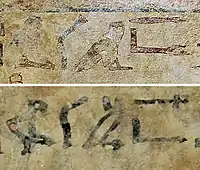Aamu
Aamu (Egyptian language: '𓂝𓄿𓅓𓅱' ꜥꜣmw) was an Egyptian name used to designate Western Asiatic foreigners in antiquity.[1] It is generally translated as "Western Asiatic", but suggestions have been made these could be identical with the Canaanites or the Amorites.[1][2]
.jpg.webp)
(𓋾𓈎𓈉 ḥḳꜣ-ḫꜣswt, Heqa-kasut for "Hyksos").
Tomb of Khnumhotep II (circa 1900 BC).[1]
| Aamu in hieroglyphs |
|---|
Abraham could have been related to the Western Asian people known to have visited Egypt during the second millennium BCE, such as the Aamu or Retjenu.[5] David Rohl proposed to identify Abraham with the Aamu, well known in Egyptian sources as a people of West Asia.[6] In Egyptian, the reading of the second aleph, when there are two consecutive alephs in a word, change to "r" or "l", so that the word Aamu, which has traditionally been suspected to mean Amorites, may actually be read "Aramu", referring to the Arameans, and associated to Abraham through the name given to him in the Bible, "Abraham the wandering Aramaean".[6] Assuming a shift to "l" as opposed to "r", the reading "Alamu" is ostensibly similar to the Ahlamu, a people whom the Aramean tribes belonged to.
An ancient Egyptian painting in the tomb of 12th Dynasty official Khnumhotep II, at Beni Hasan (c. 1900 BCE), shows a group of West Asiatic foreigners, possibly Canaanites, labelled as Aamu (ꜥꜣmw), including the leading man with a Nubian ibex labelled "Abisha the Hyksos" (𓋾𓈎𓈉 ḥḳꜣ-ḫꜣsw, Heqa-kasut for "Hyksos").[1][2][3][7] The Aamu from this relief are further labeled as being from the area of Shu, which may be identified, with some uncertainty, with the area of Moab in southern Palestine (region), around the Jordan river, or generally the southern Levant, just east of the Jordan river and the Red Sea.[8]
 Word "Aamu" (from right to left) in two Egyptian scripts, in the Procession of the Aamu, circa 1900 BCE
Word "Aamu" (from right to left) in two Egyptian scripts, in the Procession of the Aamu, circa 1900 BCE A more recent description of the word (left to right, 1898)
A more recent description of the word (left to right, 1898).png.webp) Aamu people ('𓂝𓄿𓅓𓅱' characters spread alongside each individual) in the Book of Gates (rendering)
Aamu people ('𓂝𓄿𓅓𓅱' characters spread alongside each individual) in the Book of Gates (rendering)
References
- Mieroop, Marc Van De (2010). A History of Ancient Egypt. John Wiley & Sons. p. 131. ISBN 978-1-4051-6070-4.
- Bard, Kathryn A. (2015). An Introduction to the Archaeology of Ancient Egypt. John Wiley & Sons. p. 188. ISBN 978-1-118-89611-2.
- Curry, Andrew (2018). "The Rulers of Foreign Lands - Archaeology Magazine". www.archaeology.org.
- Kamrin, Janice (2009). "The Aamu of Shu in the Tomb of Khnumhotep II at Beni Hassan" (PDF). Journal of Ancient Egyptian Interconnections. Vol. 1:3.
- Najovits, Simson (2003). Egypt, the Trunk of the Tree, Vol.II: A Modern Survey of and Ancient Land. Algora Publishing. p. 195. ISBN 978-0-87586-257-6.
- Rohl, David (2010). The Lords Of Avaris. Random House. p. 196. ISBN 978-1-4070-1092-2.
- Kamrin, Janice (2009). "The Aamu of Shu in the Tomb of Khnumhotep II at Beni Hassan" (PDF). Journal of Ancient Egyptian Interconnections. Vol. 1:3.
- Kamrin, Janice (2009). "The Aamu of Shu in the Tomb of Khnumhotep II at Beni Hassan" (PDF). Journal of Ancient Egyptian Interconnections. Vol. 1:3: 25.
.jpg.webp)
